|
|
|
From Delfzijl to Strijensas |
|
|
We arrived at Delfzijl on the 7th September in brilliant sunshine and with a choir singing on the quayside! The “ Staande Mastroute” starts here which is a network of canals where the bridges are opening ones. In other words there is no need to take the mast down. It felt exiting to be here at last, after having that talk with the nice Dutch couple in Grenå. The 23 September we arrived at Strijensas which is situated opposite Willemstad, which is the last stop of the standing mast route. We have seen a lot and experienced a lot and also met very nice people on the way. Chris and Frida, whom we met in Borkum, we met again in Amsterdam! Below you will find a few of our experiences:
|
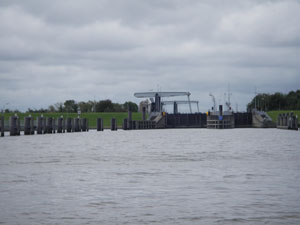 |
|
The locks, there have been plenty of them, have not been as awkward as we thought. In general the difference in height has been about a couple of decimeters. As far as bridges are concerned, we have only had to wait a longer period of time at railway bridges. The route through Amsterdam takes place during the night ( we were seven boats) after the train had passed just before 02.00. Something to think about is to have plenty of change with you. It happens that the bridge keepers stick out a fishing rod with a clog at the end of it. They expect you to put the charge in the shoe. The amount payable could vary from €2,50 to €6 at different bridges.
|
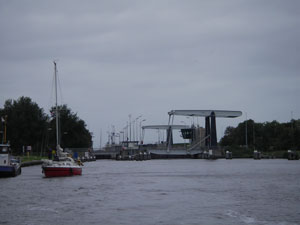 |
|
Groningen, which was the next town we arrived at after Delfzijl, is a university town with a lot of students – and bikes. This was our first encounter with Dutch people on bikes. And you had better keep your eyes open! Generally we have seen a lot of people on bikes – young as well as old. The Dutch have also planned for bikes in their infrastructure and bikes as well as other traffic seem to get along fine. In Groningen we also saw “Koffie shops” - and the aroma from these places was not ordinary coffee, that´s for sure! We saw these “Koffie-shops” in Amsterdam as well, but nowhere else.
|
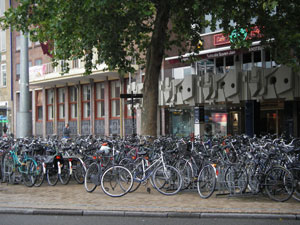 |
|
The leg between Groningen and Zoutkamp was very eventful indeed. The weather was very changeable, with both rain and sunshine. It always happened that it was windy and rainy as we waited for a bridge to open! We were five boats in a convoy going up the canal. Some went faster than the others and the same applied when we were waiting and tried to stay in the same spot until the bridge opened. It often meant that you had to circle in the narrow canal before you could carry on.
|
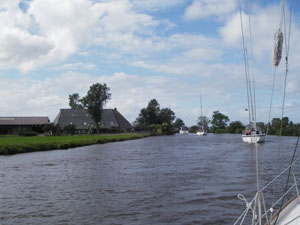 |
|
It was during one of these circling maneuvers that we came to near the side of the canal, also helped by the wind, and got stuck in the mud. What to do next? The only thing was to ask for somebody to help us off. The help came very quickly. So quickly that they actually rammed into us! In the bowsprit we also have an anchor – this anchor ended up on their deck. Their stanchion broke off. We had a job to get our boat off their deck, but managed in the end. They careered off to the other side of the canal – and got stuck in the mud! By this time the wind had blown us off the mud and we prepared ourselves to help our “helpers”. All of a sudden they got off as well. We carried on our journey…
|
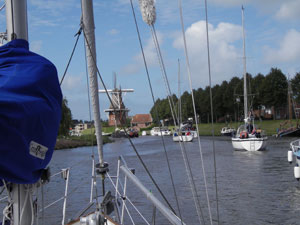 |
|
We were about 500m in front of our “helpers” when we suddenly heard: “Yohooooo! Hallooooooo!” When we turned around we saw one of their crew performing an emergency signal, i.e. both arms straight out and waving them up and down. We turned around and reached them. If we have some extra diesel with us? Of course! We passed a 10 litre can over to them and decided that we should meet up in Zoutkamp. When we got to Zoutkamp we looked forward to a nice cup of tea. This we couldn´t make as we had just run out of gas. Later in the evening we had a nice cup of coffee (warm!) in the boat of our “helpers” as we discussed the situation. Our boat had caused damage to their boat, after the fact that they decided to help us. We helped them with diesel. We decided to call it quits. Right or wrong, both parties were satisfied.
|
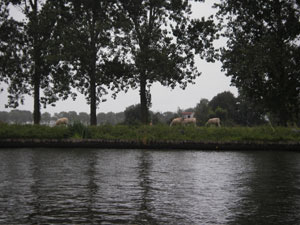 |
|
The next day we carried on to Leuwaarden and arrived in the evening. We moored at a nice park, which also had a restaurant. As we still didn´t have any gas we decided to go out to have a meal. It was a real feast! The next day we went out hunting for gas.
|
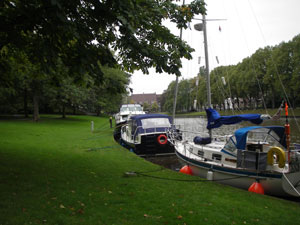 |
|
We have had many discussions about gas and gas bottles. Apparently it is very difficult to get bottles that fit the Swedish connections. We have therefore bought ourselves an adaptor. Nevertheless, we took our C10 bottle and a little camping gas bottle and went to the shop the harbour master recommended. He recommended another place and gave us instructions how to get there. After a while walking we suspected that something was wrong. We asked a bridge keeper and he informed us that we were going the wrong way. We turned back and after a while a man shouted and asked us if we wanted gas. After admitting to this he informed us that we should go to the other side of the canal. After having buzzed around for a while we saw a taxi that had stopped. We thought that he would surely know and when we had asked he commanded: “Get into the car!” After we had stuffed ourselves and bottles in the car we arrived at the gas depot five minutes later. We were rummaging for money to pay for the taxi when he turned around and told us he didn´t want any. We thanked him for his hospitality. You will find the gas depot between Eebrug and Nordenbrug (on the port side) and the owner is called Jan Rauta. Without any problems at all he filled our gas bottles to the fair price of €25. The first thing we did when we had connected the gas was – make a cup of tea, of course!
|
Sorry, no picture! |
|
For the next leg we diverted from the Staande Mastroute and took the canal to Harlingen instead. Our intention was to cross Ijsselmeer and Markemeer down to Amsterdam. We intended to do a bit of sailing before we went into the canals at Amsterdam. Harlingen is a very nice and picturesque town to stroll about in and has got a cosy guest harbour just next door to the locks. We made another stop before we got to Amsterdam and that was Enkhuizen, which is about half way.
|
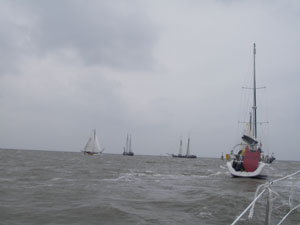 |
|
Here we noticed that our bilge pump didn´t work. The only thing was to get a new one and install it. We haven´t had any problems with water in the bilges, but we have had some when the boat has been leaning a lot, when there has been a downpour or if we have had too much diesel in the tank! |
|
|
Enkhuizen is also a very nice medieval town with narrow lanes and shops. The maritime museum is also supposed to be worth visiting. We went there to have a look – but turned around just as quick when we found out that the entry fee was €11,50 per person. It would in other words cost us €23 for a visit to a museum! In Sweden there is a debate going on whether museums should be free of charge. They have been, but through political change they are not anymore. We are of the definite opinion that they should be free of charge – it should be a right for everybody – no matter the size of your wallet. We bought a substantial bag of food for the €23 instead… |
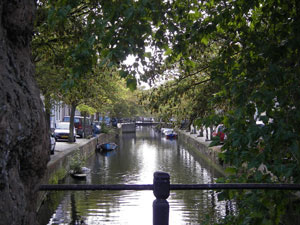 |
|
On the 16th September we hoisted our sails outside Enkhuizen for our last sail for quite some time. The wind was southwesterly and right in the nose again. This meant that we were going to tack. It was a sunny day with a steady wind of force 4-6 Bft (5,5 – 13,8 m/s). Sure, it takes time to tack – sure, the boat is leaning a lot – but isnt´t it just lovely!
|
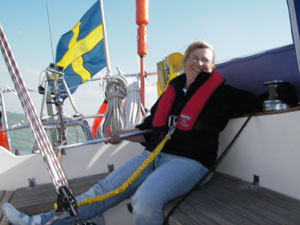 |
|
Several people have asked us about this with food. What kind of food do you cook on board? My answer has always been: ordinary food. The cooker has got two rings and an oven (gas). It can be lifted up on gimbals so that the top is level even when the boat is leaning. The saucepans are fastened with two “arms” which are screwed on at the front of the cooker. We often prepare the food in advance if we know that the trip will entail a lot of movement. This particular day we had a pork hot pot with rice. It isn´t too complicated to prepare: Cut pork into pieces and fry. Season. Fry onion and peppers (yellow, green, red) in olive oil (high temperature!). Poor Madeira sauce over the top and let simmer for about 1,5 hours. Madeira sauce? Out of a packet – of course! Not bad at all.
|
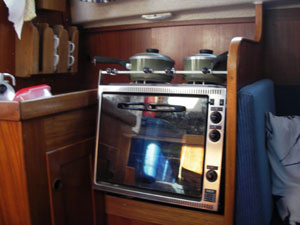 |
|
We arrived at Amsterdam just as the sun was going down and when we reached the lock it was really dark. Both the lock- and the bridge keeper saw us coming and opened up in good time for us. We found our way to Aeolus Jachthaven and the harbour master met us on his bike. This guestharbour is quite small, very informal and has access to most things. The supermarket is just around the corner. Ferries go to the centre of Amsterdam just 10 minutes walk away (free of charge). We had also reason to get hold of a Volvo Penta dealer and found one 15 minute bike ride away (Oranje Marine).
|
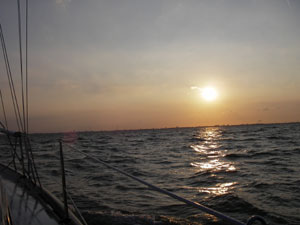 |
|
Here in Amsterdam we bought more pilot books about European canals, looked around the centre of town and mainly fixed our engine! (Pictures in our picture gallery). We discovered diesel (not a lot – but still) coming out of the exhaust pipe, the stern was black and the engine didn´t start properly. Everything was pointing to something being wrong with the fuel injectors. We took these to Oranje Marine and had them tested and they could only confirm our suspicions. New ones were ordered from Belgium, arrived the next day, and new filters were also bought. Then all we had to do was getting on with it. It felt good when we turned the engine key and found that everything was working!
|
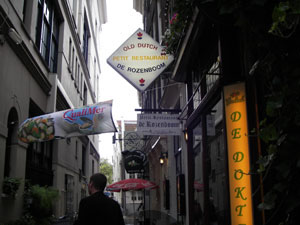 |
|
On the 21st September at 18.00 we left Aeolus harbour to join the convoy going through Amsterdam at night. Just before 2 a.m. the last train passed before the bridge could be opened. It took us two hours to get through the remaining bridges. This nightly tour didn´t turn out the way we expected. Both Mike and I expected to go through Amsterdam with bridges open and lights shining everywhere but, this was not to be. It turned out to be a dark canal with high rise flats and factories. That´s life. On the other side we moored at Driesen Jachthaven for the rest of the night.
|
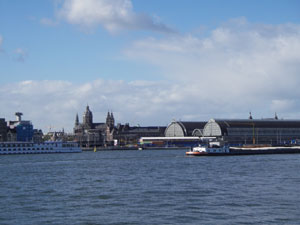 |
|
The next day we intended to get as far as possible, provided that we could get some diesel. In our Staande Mastroute-book we read that there should be a guest harbour with diesel just before Alphen a/d Rijn. Just as we had passed Braassermermeer we saw a tanker with a sign “Bunkerstation”. We filled up here. Just as well as we were told that this was the last place before Rotterdam. We got as far as Gouda and tied up by the railway bridge for the night and carried on the next day.
|
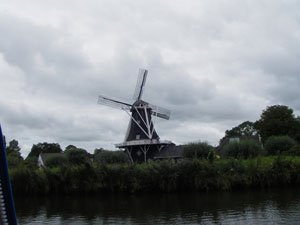 |
|
It was a nice sunny day with summer temperatures all the way to Strijensas, a guest harbour almost opposite Willemstad. On our way down there we saw a lot of nice houses and gardens, people who thought we were different because of our Swedish flag and waved to us. In Strijensas there was supposed to be a mast crane and we planned to take the mast down there. Strijensas was a nice harbour with showers, but not a supermarket. When we asked the harbour master for the nearest shop that would sell food, he explained that it would probably be too far to walk so he told us that we could borrow the harbour´s “shopping bikes”. All we had to do was to cycle 10 km. One must say that we have had some exercise during this trip…
|
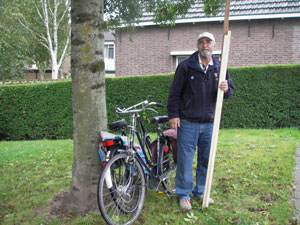 |
|
The mast came down on the 25th September and we put it back horizontally without any difficulties. Now we were ready to tackle the canals! On the 26 September we headed towards Antwerp.
|
|
|
I
|
|